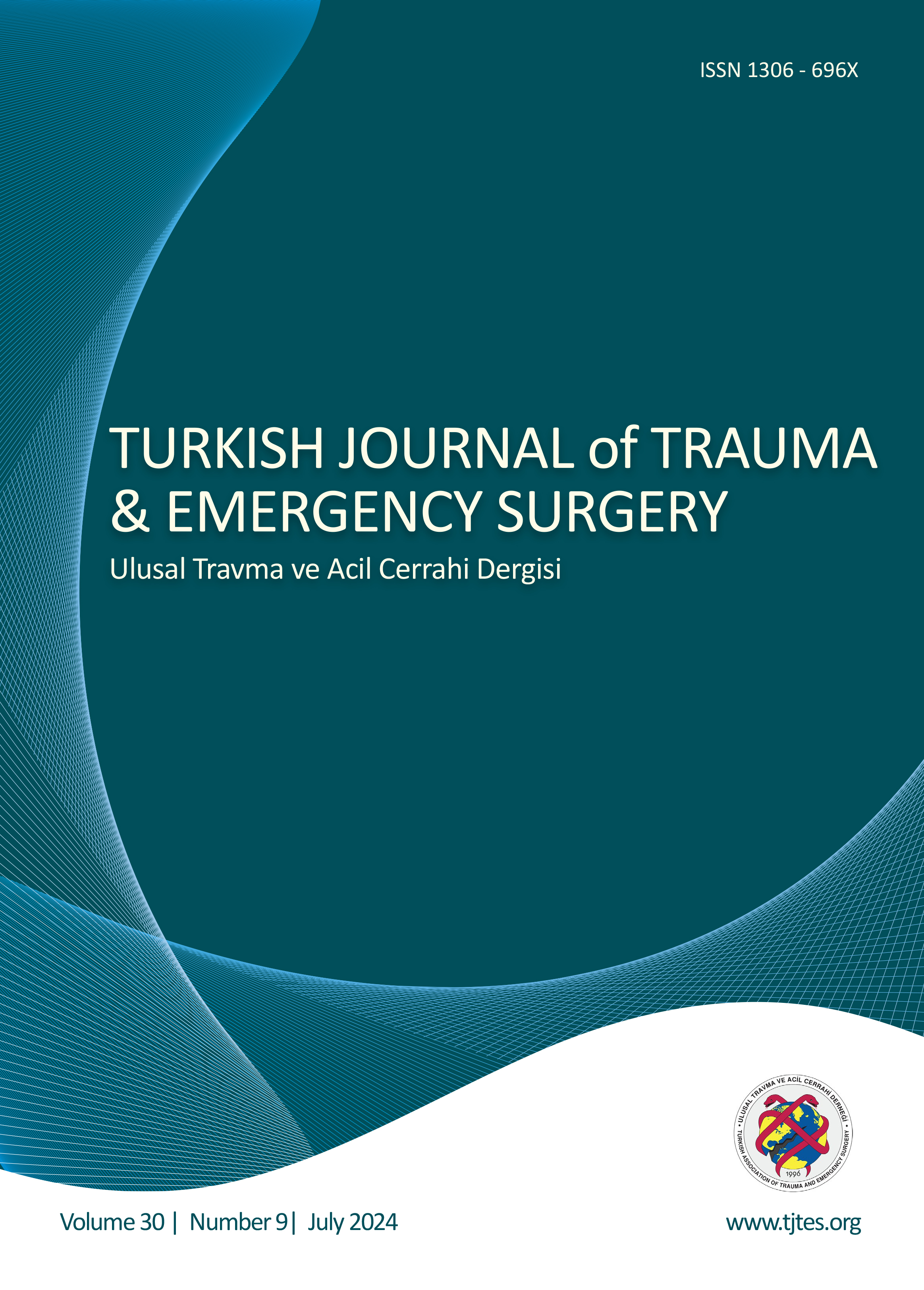Quick Search
Challenges and predictive radiological findings in the diagnosis of neuroendocrine tumors in patients with acute appendicitis
Osman Şimşek1, Sabri Şirolu2, Yağmur Özkan Irmak3, Rauf Hamid3, Sefa Ergun1, Nuray Kepil4, Onur Tutar31Department of General Surgery, Istanbul University-Cerrahpasa, Cerrahpasa Medical Faculty, Istanbul-Türkiye2Department of Radiology, Sisli Hamidiye Etfal Training and Research Hospital, Sisli, İstanbul-Türkiye
3Department of Radiology, Istanbul University-Cerrahpasa, Cerrahpasa Medical Faculty, Istanbul-Türkiye
4Department of Pathology, Istanbul University-Cerrahpasa, Cerrahpasa Medical Faculty, Istanbul-Türkiye
BACKGROUND: Acute appendicitis is one of the most common surgical emergencies. With antibiotic-first treatment strategies gaining importance, the risk of an appendiceal tumor as an incidental finding or as the cause of appendicitis presents an obstacle to a conservative approach. Neuroendocrine tumors, the most frequent type of appendiceal tumors, are difficult to diagnose preopera-tively due to their small size. This study aims to identify predictive factors for neuroendocrine tumors in patients undergoing surgery for acute appendicitis by analyzing imaging and clinical characteristics, thereby enhancing preoperative diagnostic accuracy and guiding surgical interventions.
METHODS: This retrospective observational study included 1,298 patients who underwent appendectomy from January 2014 to May 2024. After excluding 59 patients with normal pathology results, 40 with variable pathologies, and 49 with inaccessible computed tomography (CT) images, 1,150 patients remained (1,135 with acute appendicitis and 15 with neuroendocrine tumors). Abdominal CT scans were evaluated for appendiceal diameter, wall thickness, cecal wall thickness, periappendiceal fat stranding, fluid collection, lymphadenopathy, intraluminal and free periappendiceal air, mucosal hyperenhancement, the presence of appendicolith, mural calcification, and mural nodules.
RESULTS: The presence of a mural nodule protruding into the lumen was significantly higher in neuroendocrine tumor patients compared to those with acute appendicitis, with a sensitivity of 53.3%, specificity of 95.8%, positive predictive value (PPV) of 31.9%, negative predictive value (NPV) of 99.4%, and accuracy of 97.9%. Intraluminal air was also more frequent in neuroendocrine tumor patients, with a sensitivity of 53.3%, specificity of 76.7%, PPV of 2.9%, NPV of 99.2%, and accuracy of 76.4%. Other imaging parameters did not show significant differences between the two groups.
CONCLUSION: This study identifies mural nodules and intraluminal air as significant predictors of neuroendocrine tumors in patients with acute appendicitis, emphasizing the importance of meticulous preoperative imaging evaluations. Incorporating these predictors into diagnostic protocols could improve the preoperative identification of neuroendocrine tumors, enabling more appropriate surgical interventions. Future research should validate these findings through prospective studies and explore advanced imaging techniques to further enhance the detection of appendiceal neoplasms, ultimately improving patient outcomes and reducing overlooked malignancies.
Keywords: Acute appendicitis, computed tomography; neuroendocrine tumor.
Akut apandisit hastalarında nöroendokrin tümörlerin tanısında zorluklar ve prediktif radyolojik bulgular
Osman Şimşek1, Sabri Şirolu2, Yağmur Özkan Irmak3, Rauf Hamid3, Sefa Ergun1, Nuray Kepil4, Onur Tutar31İstanbul Üniversitesi-Cerrahpaşa, Cerrahpaşa Tıp Fakültesi, Genel Cerrahi Anabilim Dalı, İstanbul, Türkiye2Şişli Hamidiye Etfal Eğitim Araştırma Hastanesi, Radyoloji Anabilim Dalı, Şişli, İstanbul, Türkiye
3İstanbul Üniversitesi-Cerrahpaşa, Cerrahpaşa Tıp Fakültesi, Radyoloji Anabilim Dalı, İstanbul, Türkiye
4İstanbul Üniversitesi-Cerrahpaşa, Cerrahpaşa Tıp Fakültesi, Patoloji Anabilim Dalı, İstanbul, Türkiye
AMAÇ: Akut apandisit, en yaygın cerrahi acillerden biridir. Antibiyotiklerle tedavi stratejileri önem kazandıkça, apandisit nedeni olarak veya tesadüfi bir bulgu olarak apendiks tümörü olasılığı, konservatif yaklaşım için bir engel teşkil etmektedir. Apendiks tümörleri içinde en sık görülen ancak küçük boyutu nedeniyle preoperatif tanısı en zor konan tip olan nöroendokrin tümörler bu konuda özellikle zorluk oluşturmaktadır. Bu çalışma, görüntüleme ve klinik özellikleri analiz ederek akut apandisit nedeniyle ameliyat edilen hastalarda nöroendokrin tümörler için öngörücü faktörleri belirlemeyi, böylece preoperatif tanı doğruluğunu artırmayı ve cerrahi müdahaleleri yönlendirmeyi amaçlamaktadır.
GEREÇ VE YÖNTEM: Bu retrospektif gözlemsel çalışma, Ocak 2014 ile Mayıs 2024 arasında apendektomi yapılan 1298 hastayı içermektedir. Normal patoloji sonuçları olan 59 hasta, değişken patolojilere sahip 40 hasta ve erişilemeyen BT görüntüleri olan 49 hasta dışlandıktan sonra, 1150 hasta kaldı (1135 akut apandisit ve 15 nöroendokrin tümör). Abdominal BT taramaları, apendiks çapı, duvar kalınlığı, çekum duvar kalınlığı, peria-pendiküler yoğunluk artışı ve effüzyon, lenfadenopati, lümen içi ve serbest periapendiküler hava, mukozal kontrastlanma artışı, apendikolit varlığı, mural kalsifikasyon ve mural nodüller açısından değerlendirildi.
BULGULAR: Lümene protrüde olan mural nodül varlığı, nöroendokrin tümörlü hastalarda akut apandisitli hastalara kıyasla anlamlı derecede daha yüksekti. Bu durum, %53.3 duyarlılık, %95.8 özgüllük, %31.9 pozitif öngörü değeri (PPV), %99.4 negatif öngörü değeri (NPV) ve %97.9 doğruluk ile ölçüldü. Lümen içi hava da nöroendokrin tümörlü hastalarda daha sık görüldü ve %53.3 duyarlılık, %76.7 özgüllük, %2.9 PPV, %99.2 NPV ve %76.4 doğruluk ile değerlendirildi. Diğer görüntüleme parametreleri iki grup arasında anlamlı fark göstermedi.
SONUÇ: Bu çalışma, akut apandisitli hastalarda nöroendokrin tümörlerin öngörücüleri olarak mural nodüller ve lümen içi havanın önemli belirteçler olduğunu belirlemektedir. Bu bulguların tanı protokollerine dahil edilmesi, nöroendokrin tümörlerin preoperatif tanısını destekleyebilir ve daha uygun cerrahi müdahalelere olanak tanıyabilir. Gelecek araştırmalar, bu bulguları prospektif çalışmalarla doğrulamalı ve apendiks tümörlerinin tespiti için ileri görüntüleme tekniklerini keşfetmelidir, bu da nihayetinde hasta sonuçlarını iyileştirecek ve gözden kaçan maligniteleri azaltacaktır.
Anahtar Kelimeler: Akut apandisit, bilgisayarlı tomografi; nöroendokrin tümör.
Manuscript Language: English




